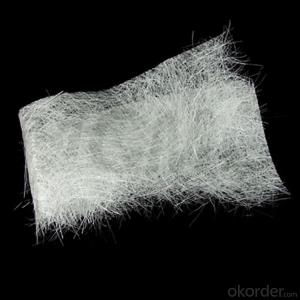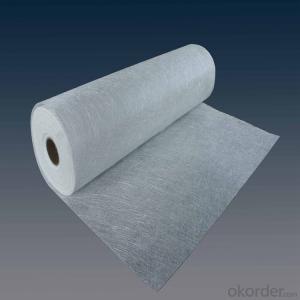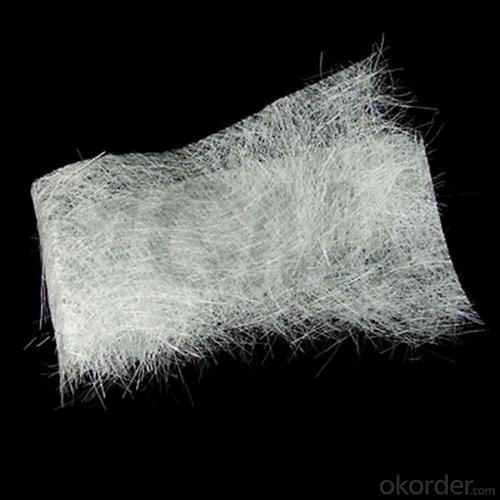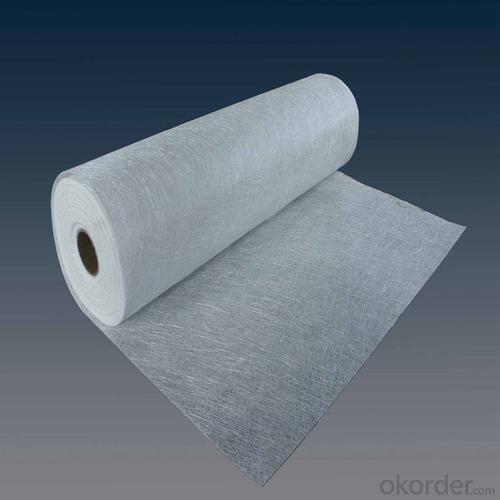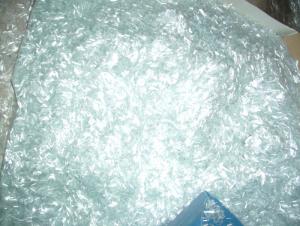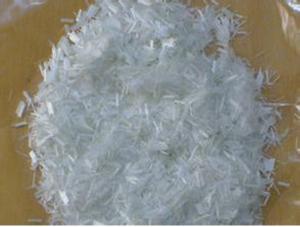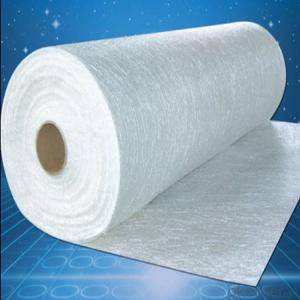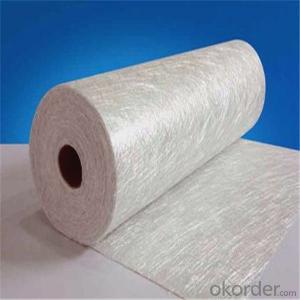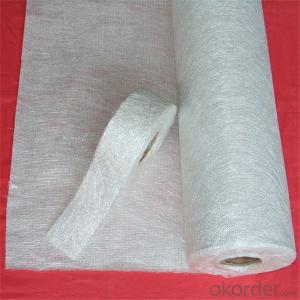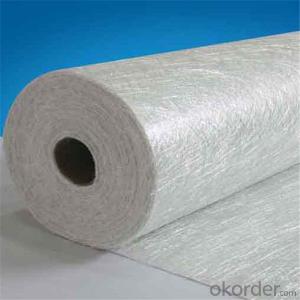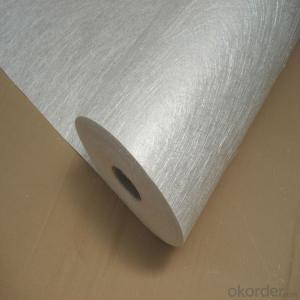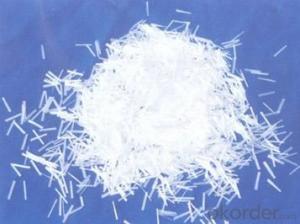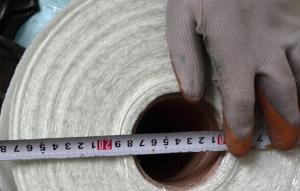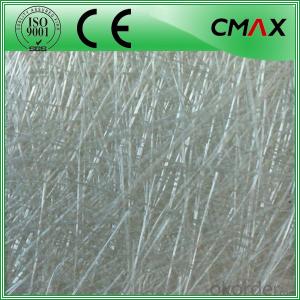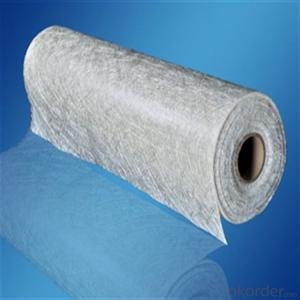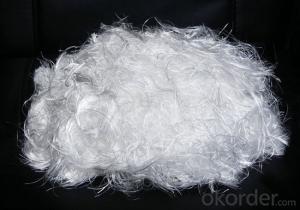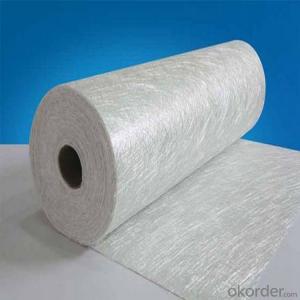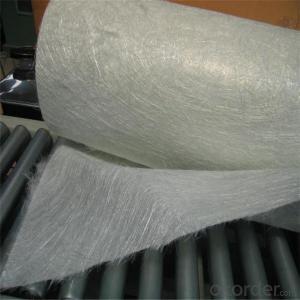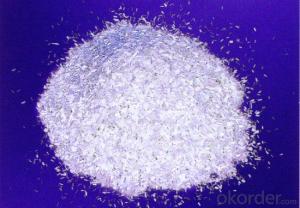AR Fiberglass Chopped Strands Mat
- Loading Port:
- China main port
- Payment Terms:
- TT OR LC
- Min Order Qty:
- 1 kg
- Supply Capability:
- 5000 kg/month
OKorder Service Pledge
OKorder Financial Service
You Might Also Like
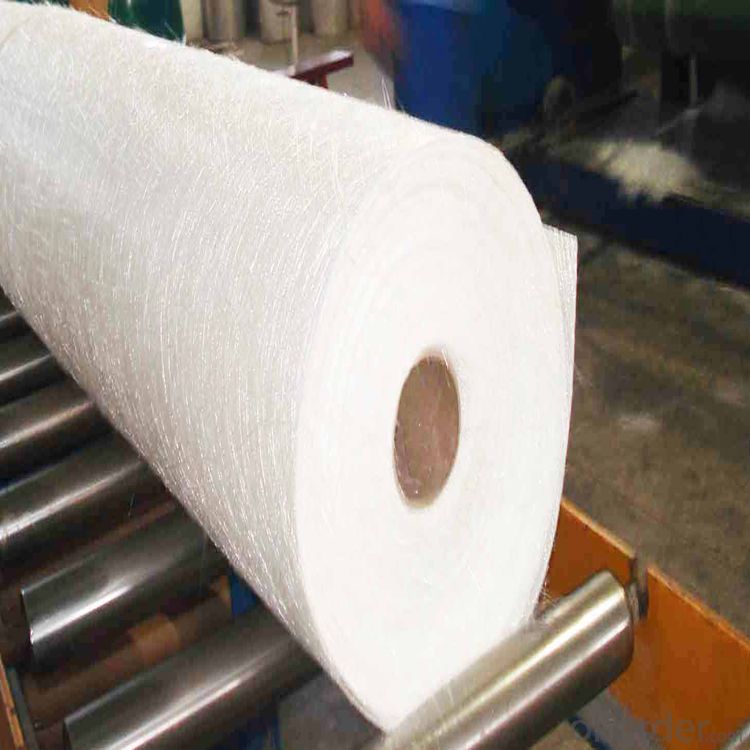
Product Description:
Fiberglass Chopped Strand Mat is fine strand reinforcement material made from E-glass cut fibers laid in a random pattern and bonded with powder or emulsion binder.
It is easy to handle and has excellent moulding performance.
Also, it has rapid resin penetration together with a fast strand wet out time.
The mat also brings a highly translucent finished laminates.
Also,the fine strand input makes the fiber prominence at the finished laminates surface extremely low.
Features
1.Excellent weight uniformity
2.Fast wet out
3.Easy air release
4.Excellent transparency of finished products
5.Excellent laminate
6.Low resin consumption
Application
1.Translucent roof panel
2.chemical storage tanks
3.FRP pipes
4.Boat hulls
5.Decks
6.Truck body panel
7.Cooling towers
8.Corrosion resistand
Specifications:
Item | Over Density | Moisture Content | Chop Density | Polyester Yarn | Width |
(g/m2) | (%) | (g/m2) | (g/m2) | (mm) | |
EMK300 | 309.5 | ≤0.15 | 300 | 9.5 | 50-3300 |
EMK380 | 399 | 380 | 19 | ||
EMK450 | 459.5 | 450 | 9.5 | ||
EMK450 | 469 | 450 | 19 | ||
EMC0020 | 620.9 | 601.9 | 19 | ||
EMC0030 | 909.5 | 900 | 9.5 |
Special products are available according to customer’s requirement.
Product Packaging:
Each Surface Tissue is wound onto a paper tube which has an inside diameter of 76mm and the mat roll has a diameter of 330mm. The mat roll is wrapped up with plastic film,and then packed in a cardboard box or wrapped up with kraft paper. The rolls can be vertically or horizontally placed. For transportation, the rolls can be loaded into a cantainer directly or on pallets.
Quantity
20'GP Container:About 10000kgs
40'HP Container:Aboout 23100kgs
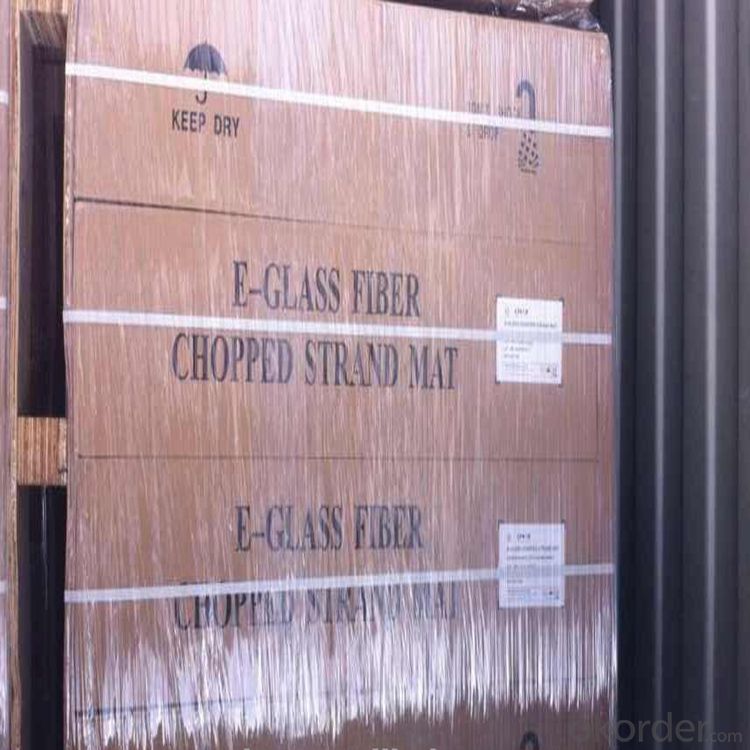
Product Storage:
Unless otherwise specified, Chopped Strand Mat should be stored in a dry, cool and rain-proof area. It is recommended that the room temperature and humidity should be always maintained at 15℃~35℃ and 50%~75% respectively.
Company Information
CNBM (China National Building Material) Group is the largest comprehensive building materials group in China that in integrate scientific research, manufacturing and logistics into one entity. The largest building materials and equipment specialists in China. Upon State Council approval, today CNBM owned more than 300 subordinate manufacturing factories and servicing companies. There are 6 fully owned public listed companies and 11 partially owned with substantial shares public listed companies. In many of these fields, CNBM is playing the leading role in the building industry in the country.
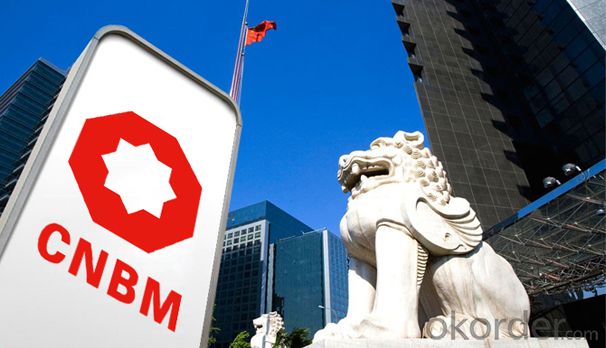
Our Service:
1.Any inquiry will be replied within 24 hours.
2.Professional manufacturer.
1) Print logo in the products;
2) The size and specification can be produce and design according to your demand.
3.High quality,fashion designs,reasonable and competitive price,fast lead time.
4.After-sale service
1) All products will have been strictly quality check in house before packing.
2) All products will be well packed before shipping.
3) All our products have 10 years rot resistance.
5.Faster delivery:sample order in stock,and 15-20 days for bulk production.
6.Payment:you can pay for the order via:T/T,Western Union,MoneyGram,L/C etc.
FAQ:
which kind of glass fiber sample and materials can you provide?
We can provide the glass fiber and glass fiber down stream products samples of E glass, C glass, ECR glass, High alkali glass. The products includes single end roving, assembled roving for different applications( Piping, SMC, panel, winding mill plate) , chop strand for BMC, engineering plastic (PA, PPA, PPT, POM, etc), chop strand mat (from 100gsm-900gsm) for automobile and water tank, etc, woven roving (270gsm-800gsm), surface tissue (25-50gsm), multi-axial fabric of different unit weight.
- Q: Can fiberglass chopped strand be used in construction?
- Yes, fiberglass chopped strand can be used in construction. It is commonly used as a reinforcement material in various construction applications such as concrete, roofing, insulation, and composite panels. It enhances the strength, durability, and fire resistance of the construction materials.
- Q: What are the typical compression properties of fiberglass chopped strand composites?
- The typical compression properties of fiberglass chopped strand composites can vary depending on factors such as the type and orientation of the fibers, resin matrix, and manufacturing process. However, generally speaking, fiberglass chopped strand composites exhibit good compression strength and stiffness. The compressive strength of fiberglass chopped strand composites is typically high, making them suitable for structural applications where load-bearing capabilities are required. The strength can vary based on the specific composition, but it is often comparable or even superior to other commonly used composites, such as carbon fiber composites. In terms of stiffness, fiberglass chopped strand composites also perform well. The fibers provide reinforcement, increasing the overall stiffness of the composite material. This stiffness is particularly advantageous in applications where rigidity and dimensional stability are essential. It is worth noting that the compression properties of fiberglass chopped strand composites can be tailored to meet specific requirements by adjusting factors such as fiber content, fiber orientation, and resin selection. By varying these parameters, manufacturers can optimize the compression performance of the composites for different applications. Overall, fiberglass chopped strand composites are known for their strong compression properties, combining high strength and stiffness. These properties make them suitable for a wide range of applications, including automotive components, aerospace structures, sporting goods, and construction materials.
- Q: Does fiberglass chopped strand improve the chemical resistance of composite materials?
- The chemical resistance of composite materials can be enhanced through the incorporation of fiberglass chopped strand. Fiberglass possesses exceptional chemical resistance due to its inert nature and lack of reactivity with most chemicals. When utilized as a reinforcement in composite materials, particularly in fiberglass-reinforced plastics (FRPs), the chopped strand contributes to an overall improvement in chemical resistance. By reinforcing the composite matrix, the chopped strand augments its strength and durability. This reinforcement effectively impedes the infiltration and absorption of chemicals, thereby heightening the composite material's resistance to chemical attacks. Moreover, the fiberglass chopped strand can function as a protective barrier, preventing the chemicals from reaching the underlying layers of the composite and causing harm. To further enhance the chemical resistance of composite materials, it is crucial to select the appropriate type and sizing of the fiberglass chopped strand. Different types of fiberglass, such as E-glass, S-glass, and boron fibers, offer varying degrees of chemical resistance. Additionally, the application of a specific sizing or coating to the chopped strand can also bolster its chemical resistance properties. Nevertheless, it is important to acknowledge that while the incorporation of fiberglass chopped strand can enhance the chemical resistance of composite materials, it does not render them completely impervious to all types of chemicals. Certain aggressive chemicals, such as potent acids or bases, may still elicit damage to the composite, even with the presence of fiberglass chopped strand. Consequently, it is imperative to consider the precise chemical environment in which the composite will be utilized and accordingly select suitable materials and reinforcements.
- Q: Is glass fiber reinforced plastic products industry a polluting industries?
- Code of short cut glass fiber is ABS, glass fiber chopped into all kinds of plastic, like BMC fiber diameter, chopping yarn, Jushi chopping glass fiber, PP, alkali free glass fiber, are made by wet process chopping method. Because the appearance is a certain length of velvet barba: 9 - 13μm water content, PBT.1% : Using special treating compound to draw raw silk, chopped with uniform dispersion, glass steel, BMC in industrial use, feeding ways, improve the impact toughness of concrete, the performance depends on the performance of the basic raw material of glass fiber filament: R2O content. 3, Chopping glass fiber, so it can be used in the field of filament can not be suitable for: Application of silane resin, auto parts, friction materials, glass fiber chopped is added to prevent crack occurrence and expansion of the role of cement and concrete, it could be enhanced obviously.
- Q: Can fiberglass chopped strand be used for reinforcing ceramic matrix composites?
- Fiberglass chopped strand is not suitable for reinforcing ceramic matrix composites. These composites need materials that can withstand high temperatures and offer exceptional mechanical properties in elevated temperatures. However, fiberglass may lack the required thermal stability to endure the extreme temperatures necessary for ceramic matrix composites. Moreover, the thermal expansion coefficients of fiberglass and ceramics often differ significantly, resulting in poor compatibility and potential composite failure. Consequently, alternative fibers such as carbon fibers or silicon carbide fibers, which are known for their high-temperature resistance, are commonly employed for reinforcing ceramic matrix composites.
- Q: How does the weatherability of fiberglass chopped strand compare to other reinforcing materials?
- Compared to numerous other reinforcing materials, fiberglass chopped strand is considered to possess superior weatherability. Its exceptional resistance to weathering, including exposure to sunlight, rain, and extreme temperatures, is well-known. Unlike materials like steel or aluminum, fiberglass does not undergo rusting or corrosion when subjected to moisture or environmental elements. This quality makes fiberglass an ideal selection for outdoor applications where durability and long-term performance are of great importance. Furthermore, fiberglass exhibits a high resistance to UV radiation, which has the potential to cause degradation and discoloration in certain materials over time. This implies that fiberglass chopped strand can retain its strength and appearance even with prolonged exposure to sunlight. Moreover, fiberglass is non-conductive and does not react to chemicals or pollutants commonly present in the environment. This attribute renders it highly resistant to chemical degradation, ensuring its performance and integrity under diverse weather conditions. To summarize, the weatherability of fiberglass chopped strand is excellent and surpasses that of many other reinforcing materials in terms of resistance to weathering, UV radiation, moisture, and chemical degradation. Its long-lasting durability makes it the preferred choice for a wide array of applications, including the construction, automotive, marine, and aerospace industries.
- Q: How does the color of the chopped strand affect its performance?
- The color of chopped strand can affect its performance in several ways. Firstly, the color can indicate the type of resin or binder that is used to hold the strands together. Different resins have different properties and can impact the strength, flexibility, and overall performance of the chopped strand. Additionally, the color of the chopped strand can also affect its adhesion properties. Some colors may have better adhesion to certain materials or substrates, while others may not adhere as well. This can impact the overall strength and durability of the final product. Furthermore, the color of the chopped strand can also affect its UV resistance. Certain colors may be more resistant to UV degradation, which is important in applications where the material will be exposed to sunlight or outdoor conditions. This can help prevent the material from becoming brittle or discolored over time. Lastly, the color of chopped strand can also impact its aesthetic appeal. In applications where the appearance is important, such as in automotive or consumer products, the color of the chopped strand can contribute to the overall visual appeal of the finished product. In summary, the color of chopped strand can affect its performance by influencing the type of resin used, adhesion properties, UV resistance, and aesthetic appeal. It is important to consider these factors when selecting chopped strand for a specific application to ensure optimal performance and desired outcomes.
- Q: How does the fiber-matrix adhesion of fiberglass chopped strand affect the performance of composites?
- The overall performance of composites is heavily influenced by the adhesion between the fiberglass chopped strand and the matrix. Several important properties, such as mechanical strength, durability, and resistance to various environmental factors, are directly affected by the adhesion between the fibers and the matrix. To begin with, a robust fiber-matrix adhesion greatly strengthens the composite material mechanically. When there is a strong bond between the matrix and the fibers, stress can be efficiently transferred from the matrix to the fibers, resulting in improved load-bearing capabilities. This adhesion prevents the fibers from slipping or being pulled out of the matrix, thereby increasing the composite's resistance to deformation and enhancing its overall structural integrity. Moreover, a high fiber-matrix adhesion facilitates better energy transfer between the fibers and the matrix, leading to enhanced impact resistance. This is particularly important in applications where the composite is subjected to dynamic loads or impacts, such as in the automotive or aerospace industries. A strong adhesion between the fibers and the matrix allows the composite to absorb and dissipate energy more effectively, reducing the risk of failure or damage. Furthermore, the durability of composites is influenced by the adhesion between the fibers and the matrix. A good adhesion can prevent moisture or other environmental factors from penetrating the interface between the fibers and the matrix, reducing the risk of delamination or degradation. This ensures that the composite retains its properties over an extended period, making it suitable for long-term applications. Additionally, the fiber-matrix adhesion plays a role in the composite's resistance to various chemicals and corrosion. A strong bond between the fibers and the matrix can prevent chemical substances from penetrating the interface and causing damage to the composite. This enables the material to withstand exposure to harsh chemicals, acids, or alkalis, making it suitable for applications in corrosive environments. In conclusion, the fiber-matrix adhesion of fiberglass chopped strand has a significant impact on the performance of composites. A strong adhesion enhances the mechanical strength, impact resistance, durability, and resistance to chemicals and corrosion. Therefore, it is crucial to optimize the fiber-matrix adhesion in order to maximize the performance and reliability of composite materials.
- Q: How is the dimensional stability of fiberglass chopped strand composites determined?
- Various testing methods and evaluations are employed to determine the dimensional stability of fiberglass chopped strand composites. One commonly utilized approach is the coefficient of thermal expansion (CTE) test, which quantifies the material's dimensional changes in response to temperature fluctuations. Another method involves conducting a moisture absorption test, which gauges the composite material's ability to absorb and retain moisture over time. This test is crucial in assessing the composite's stability in humid or wet environments, as moisture absorption can lead to dimensional alterations. Furthermore, the creep test is performed to evaluate the composite's resistance to deformation under continuous load over an extended duration. Through this test, the dimensional changes that occur when the material is subjected to constant stress can be measured. Moreover, dimensional stability can also be evaluated by examining the composite's mechanical properties, such as tensile strength, flexural strength, and impact resistance. These properties indirectly reflect the material's behavior under stress and aid in assessing its dimensional stability. In conclusion, a combination of these tests and evaluations is utilized to ascertain the dimensional stability of fiberglass chopped strand composites, ensuring their suitability for various applications.
- Q: How is fiberglass chopped strand used in the renewable energy sector?
- Fiberglass chopped strand is commonly used in the renewable energy sector for reinforcing and strengthening various components of wind turbine blades. The chopped strands are typically mixed with resin to create composite materials that provide enhanced durability, flexibility, and lightweight characteristics. This reinforcement helps to increase the overall efficiency and lifespan of wind turbine blades, enabling them to generate more energy and withstand harsh environmental conditions.
Send your message to us
AR Fiberglass Chopped Strands Mat
- Loading Port:
- China main port
- Payment Terms:
- TT OR LC
- Min Order Qty:
- 1 kg
- Supply Capability:
- 5000 kg/month
OKorder Service Pledge
OKorder Financial Service
Similar products
Hot products
Hot Searches
Related keywords

